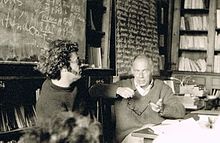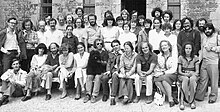Claude Simon
Claude Simon | |
|---|---|
 Simon in 1967 | |
| Born | 10 October 1913 Antananarivo, French Madagascar |
| Died | 6 July 2005 (aged 91) Paris, France |
| Occupation | Novelist |
| Nationality | French |
| Notable awards | Nobel Prize in Literature 1985 |
| Spouse | Rea Simon (died 2017) |
Claude Simon (French: [klod simɔ̃]; 10 October 1913 – 6 July 2005) was a French novelist and was awarded the 1985 Nobel Prize in Literature.
Biography
Claude Simon was born in
After secondary school at
He lived in Paris and used to spend part of the year at Salses in the Pyrenees.
In 1960, he was a signatory to the Manifesto of the 121 in favour of Algerian independence. In 1961 Claude Simon received the prize of L'Express for La Route des Flandres and in 1967 the Médicis prize for Histoire. The University of East Anglia made him an honorary doctor in 1973.
Novels
Much of Claude Simon's writing is autobiographical, dealing with personal experiences from World War II and the Spanish Civil War, and his family history. His early novels are largely traditional in form, but with Le vent (1957) and L'Herbe (1958) he developed a style associated with the Nouveau roman. La Route de Flandres (1960), which tells about wartime experiences, earned him the L'Express prize and international recognition. In Triptyque (1973) three different stories are mixed together without paragraph breaks. The novels Histoire (1967), Les Géorgiques (1981) and L'Acacia (1989) are largely about Simon's family history.[1]
Style and influences
Simon is often identified with the nouveau roman movement exemplified in the works of Alain Robbe-Grillet and Michel Butor, and while his fragmented narratives certainly contain some of the formal disruption characteristic of that movement (in particular Histoire, 1967, and Triptyque, 1973), he nevertheless retains a strong sense of narrative and character.[2]
In fact, Simon arguably has much more in common with his Modernist predecessors than with his contemporaries; in particular, the works of
The Faulknerian influence is evident in the novels' extensive use of a fractured timeline with frequent and potentially disorienting analepsis (moments of chronological discontinuity), and of an extreme form of
Themes
Despite these influences, Simon's work is thematically and stylistically highly original. War is a constant and central theme (indeed it is present in one form or another in almost all of Simon's published works), and Simon often contrasts various individuals' experiences of different historical conflicts in a single novel; World War I and the Second World War in L'Acacia (which also takes into account the impact of war on the widows of soldiers), the French Revolutionary Wars and the Second World War in Les Géorgiques.
In addition, many of the novels deal with the notion of family history, those myths and legends which are passed down through generations and which conspire in Simon's work to affect the protagonists' lives. In this regard, the novels make use of a number of leitmotifs which recur in different combinations between novels (a technique also employed by Marguerite Duras), in particular, the suicide of an eighteenth-century ancestor and the death of a contemporary relative by sniper-fire. Finally, almost all of Simon's novels feature horses; Simon was himself an accomplished equestrian and fought in a mounted regiment during World War II (the ridiculousness of mounted soldiers fighting in a mechanised war is a major theme of La Route des Flandres and Les Géorgiques).
Simon's principal obsession, however, is with the ways in which humans experience time (another Modernist fascination). The novels often dwell on images of old age, such as the decaying 'LSM' or the old woman (that 'flaccid and ectoplasmic Cassandra') in Les Géorgiques, which are frequently seen through the uncomprehending eyes of childhood. Simon's use of family history equally attempts to show how individuals exist in history—that is, how they might feel implicated in the lives and stories of their ancestors who died long ago.
Seminars


Jean Ricardou (Director) :
- Nouveau roman : hier, aujourd'hui, Cerisy (France), 1971.[3]
- Claude Simon : analyse, théorie, Cerisy (France), 1974.[4]
- Pour une théorie matérialiste du texte, Cerisy (France), 1980.[5]
Criticism
Essayist Christopher Hitchens criticised Simon's deconstruction of George Orwell's account of the Spanish Civil War, claiming that Simon had himself fought "on the side of the Stalintern forces." In a further reference to the literary honours bestowed on Simon, Hitchens added: "the award of the Nobel Prize to such a shady literary enterprise is a minor scandal, reflecting the intellectual rot which had been spread by pseudo intellectuals."[6]
Works
- Le Tricheur (The Cheat) 1946
- La Corde Raide (The Tightrope) 1947
- Gulliver 1952
- Le Sacre du printemps (The Rite of Spring) 1954
- Le vent: Tentative de restitution d 'un rétable baroque (The Wind: Attempted Restoration of a Baroque Altarpiece) 1957
- L'Herbe (The Grass) 1958
- La Route des Flandres (The Flanders Road) 1960
- Le Palace (The Palace) 1962
- La Separation (The Separation) 1963; play, adapted from the novel L'Herbe
- Femmes, sur 23 peintures de Joan Miró (Women, on 23 paintings by Joan Miró) 1966; new edition, La Chevelure de Bérénice (Berenice's Hair) 1984
- Histoire (Story) 1967
- La Bataille de Pharsale (The Battle of Pharsalus) 1969
- Orion aveugle: Essai (Blind Orion: Essay) 1970
- Les Corps conducteurs (Conducting Bodies) 1971
- Triptyque (Triptych) 1973
- Leçon de choses (Lesson in Things) 1975
- Les Géorgiques (The Georgics) 1981
- L'Invitation (The Invitation) 1987
- L'Acacia (The Acacia) 1989
- Le jardin des plantes (The Garden of Plants) 1997
- Le tramway (The Trolley) 2001
Collected edition
Œuvres (Bibliothèque de la Pléiade):
- Tome I (Gallimard, 2006), including Le Vent: Tentative de restitution d'un retable baroque, La Route des Flandres, Le Palace, La Bataille de Pharsale, La Chevelure de Bérénice (Reprise du texte Femmes), Triptyque, Le Jardin des Plantes, and other writings.
- Tome II (Gallimard, 2013), including L'Herbe, Histoire, Les Corps conducteurs, Leçon de choses, Les Géorgiques, L'Invitation, L'Acacia, Le Tramway, and other writings.
References
- ^ "Claude Simon". authorscalendar.info. Retrieved 4 February 2024.
- ^ Entre tradition et modernité (1967–1980). ccic-cerisy.asso.fr
- ^ "Cerisy, le Centre Culturel International". www.ccic-cerisy.asso.fr. Retrieved 4 February 2024.
- ^ "CERISY, les colloques (1952 - 2021)". www.ccic-cerisy.asso.fr. Retrieved 4 February 2024.
- ^ "CERISY, les colloques (1952 - 2021)". www.ccic-cerisy.asso.fr. Retrieved 4 February 2024.
- ISBN 0-465-03050-5, p. 144.
Further reading
- Brigitte Ferrato-Combe, Ecrire en peintre: Claude Simon et la peinture, ELLUG, Grenoble 1998
- Bernard Luscans, La représentation dans le nouveau nouveau roman, Chapel Hill, Université de Caroline du Nord, 2008.[1]
- Mireille Calle-Gruber, Claude Simon, une vie à écrire, Paris, Ed. du Seuil, 2011.
- ISBN 978-99967-795-6-5
- Karen L. Gould and R. Birn (Editors), Orion Blinded: Essays on Claude Simon, Bucknell University Press, 1981.
- Ilias Yocaris, L’impossible totalité. Une étude de la complexité dans l’œuvre de Claude Simon, http://revel.unice.fr/loxias/index.html?id=107, Toronto, Paratexte, 2002.
- Ilias Yocaris : « Vers un nouveau langage romanesque : le collage citationnel dans La Bataille de Pharsale de Claude Simon », Revue Romane, 43, 2, 2008, p. 303–327.
- Ilias Yocaris & David Zemmour : « Qu’est-ce qu’une fiction cubiste ? La "construction textuelle du point de vue" dans L’Herbe et La Route des Flandres », Semiotica, 195, 2013, p. 1-44, https://www.linguistiquefrancaise.org/articles/cmlf/pdf/2010/01/cmlf2010_000086.pdf
External links
- About Claude Simon
- Association des Lecteurs de Claude Simon (ALCS) website for readers of Claude Simon (articles in french and in english)
- Claude Simon on Nobelprize.org
- Petri Liukkonen. "Claude Simon". Books and Writers.
- Alexandra Eyle (Spring 1992). "Claude Simon, The Art of Fiction No. 128". The Paris Review. Spring 1992 (122).
